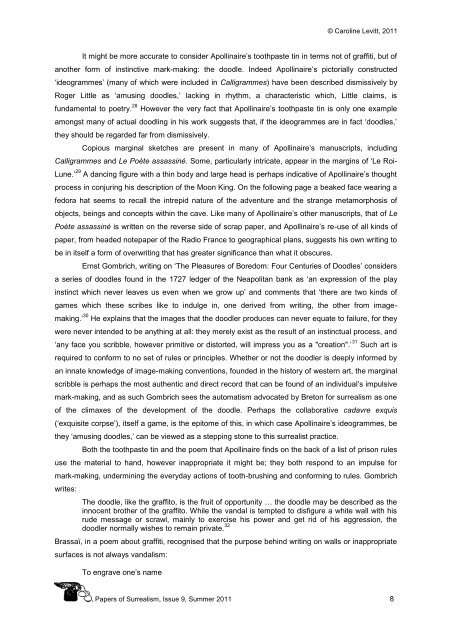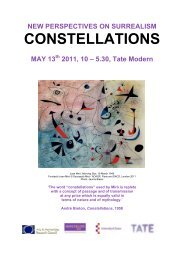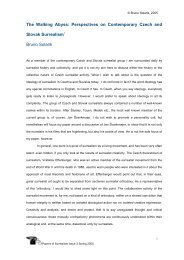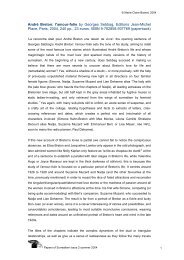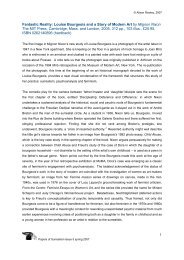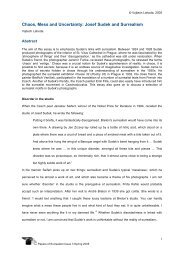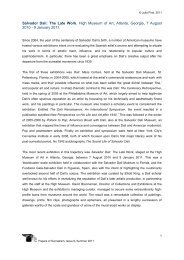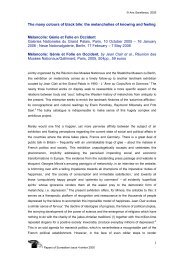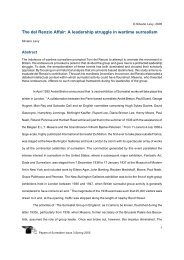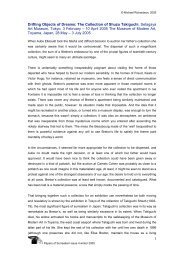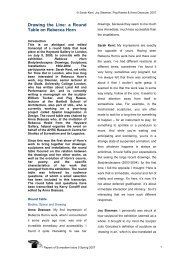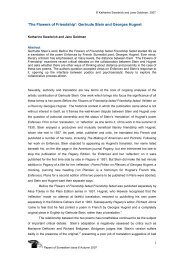From the Walls of Factories to the Poetry of the Street: Inscriptions ...
From the Walls of Factories to the Poetry of the Street: Inscriptions ...
From the Walls of Factories to the Poetry of the Street: Inscriptions ...
Create successful ePaper yourself
Turn your PDF publications into a flip-book with our unique Google optimized e-Paper software.
© Caroline Levitt, 2011<br />
It might be more accurate <strong>to</strong> consider Apollinaire‟s <strong>to</strong>othpaste tin in terms not <strong>of</strong> graffiti, but <strong>of</strong><br />
ano<strong>the</strong>r form <strong>of</strong> instinctive mark-making: <strong>the</strong> doodle. Indeed Apollinaire‟s pic<strong>to</strong>rially constructed<br />
„ideogrammes‟ (many <strong>of</strong> which were included in Calligrammes) have been described dismissively by<br />
Roger Little as „amusing doodles,‟ lacking in rhythm, a characteristic which, Little claims, is<br />
fundamental <strong>to</strong> poetry. 28 However <strong>the</strong> very fact that Apollinaire‟s <strong>to</strong>othpaste tin is only one example<br />
amongst many <strong>of</strong> actual doodling in his work suggests that, if <strong>the</strong> ideogrammes are in fact „doodles,‟<br />
<strong>the</strong>y should be regarded far from dismissively.<br />
Copious marginal sketches are present in many <strong>of</strong> Apollinaire‟s manuscripts, including<br />
Calligrammes and Le Poète assassiné. Some, particularly intricate, appear in <strong>the</strong> margins <strong>of</strong> „Le Roi-<br />
Lune.‟ 29 A dancing figure with a thin body and large head is perhaps indicative <strong>of</strong> Apollinaire‟s thought<br />
process in conjuring his description <strong>of</strong> <strong>the</strong> Moon King. On <strong>the</strong> following page a beaked face wearing a<br />
fedora hat seems <strong>to</strong> recall <strong>the</strong> intrepid nature <strong>of</strong> <strong>the</strong> adventure and <strong>the</strong> strange metamorphosis <strong>of</strong><br />
objects, beings and concepts within <strong>the</strong> cave. Like many <strong>of</strong> Apollinaire‟s o<strong>the</strong>r manuscripts, that <strong>of</strong> Le<br />
Poète assassiné is written on <strong>the</strong> reverse side <strong>of</strong> scrap paper, and Apollinaire‟s re-use <strong>of</strong> all kinds <strong>of</strong><br />
paper, from headed notepaper <strong>of</strong> <strong>the</strong> Radio France <strong>to</strong> geographical plans, suggests his own writing <strong>to</strong><br />
be in itself a form <strong>of</strong> overwriting that has greater significance than what it obscures.<br />
Ernst Gombrich, writing on „The Pleasures <strong>of</strong> Boredom: Four Centuries <strong>of</strong> Doodles‟ considers<br />
a series <strong>of</strong> doodles found in <strong>the</strong> 1727 ledger <strong>of</strong> <strong>the</strong> Neapolitan bank as „an expression <strong>of</strong> <strong>the</strong> play<br />
instinct which never leaves us even when we grow up‟ and comments that „<strong>the</strong>re are two kinds <strong>of</strong><br />
games which <strong>the</strong>se scribes like <strong>to</strong> indulge in, one derived from writing, <strong>the</strong> o<strong>the</strong>r from imagemaking.‟<br />
30 He explains that <strong>the</strong> images that <strong>the</strong> doodler produces can never equate <strong>to</strong> failure, for <strong>the</strong>y<br />
were never intended <strong>to</strong> be anything at all: <strong>the</strong>y merely exist as <strong>the</strong> result <strong>of</strong> an instinctual process, and<br />
„any face you scribble, however primitive or dis<strong>to</strong>rted, will impress you as a "creation".‟ 31 Such art is<br />
required <strong>to</strong> conform <strong>to</strong> no set <strong>of</strong> rules or principles. Whe<strong>the</strong>r or not <strong>the</strong> doodler is deeply informed by<br />
an innate knowledge <strong>of</strong> image-making conventions, founded in <strong>the</strong> his<strong>to</strong>ry <strong>of</strong> western art, <strong>the</strong> marginal<br />
scribble is perhaps <strong>the</strong> most au<strong>the</strong>ntic and direct record that can be found <strong>of</strong> an individual‟s impulsive<br />
mark-making, and as such Gombrich sees <strong>the</strong> au<strong>to</strong>matism advocated by Bre<strong>to</strong>n for surrealism as one<br />
<strong>of</strong> <strong>the</strong> climaxes <strong>of</strong> <strong>the</strong> development <strong>of</strong> <strong>the</strong> doodle. Perhaps <strong>the</strong> collaborative cadavre exquis<br />
(„exquisite corpse‟), itself a game, is <strong>the</strong> epi<strong>to</strong>me <strong>of</strong> this, in which case Apollinaire‟s ideogrammes, be<br />
<strong>the</strong>y „amusing doodles,‟ can be viewed as a stepping s<strong>to</strong>ne <strong>to</strong> this surrealist practice.<br />
Both <strong>the</strong> <strong>to</strong>othpaste tin and <strong>the</strong> poem that Apollinaire finds on <strong>the</strong> back <strong>of</strong> a list <strong>of</strong> prison rules<br />
use <strong>the</strong> material <strong>to</strong> hand, however inappropriate it might be; <strong>the</strong>y both respond <strong>to</strong> an impulse for<br />
mark-making, undermining <strong>the</strong> everyday actions <strong>of</strong> <strong>to</strong>oth-brushing and conforming <strong>to</strong> rules. Gombrich<br />
writes:<br />
The doodle, like <strong>the</strong> graffi<strong>to</strong>, is <strong>the</strong> fruit <strong>of</strong> opportunity … <strong>the</strong> doodle may be described as <strong>the</strong><br />
innocent bro<strong>the</strong>r <strong>of</strong> <strong>the</strong> graffi<strong>to</strong>. While <strong>the</strong> vandal is tempted <strong>to</strong> disfigure a white wall with his<br />
rude message or scrawl, mainly <strong>to</strong> exercise his power and get rid <strong>of</strong> his aggression, <strong>the</strong><br />
doodler normally wishes <strong>to</strong> remain private. 32<br />
Brassaï, in a poem about graffiti, recognised that <strong>the</strong> purpose behind writing on walls or inappropriate<br />
surfaces is not always vandalism:<br />
To engrave one‟s name<br />
Papers <strong>of</strong> Surrealism, Issue 9, Summer 2011 8


